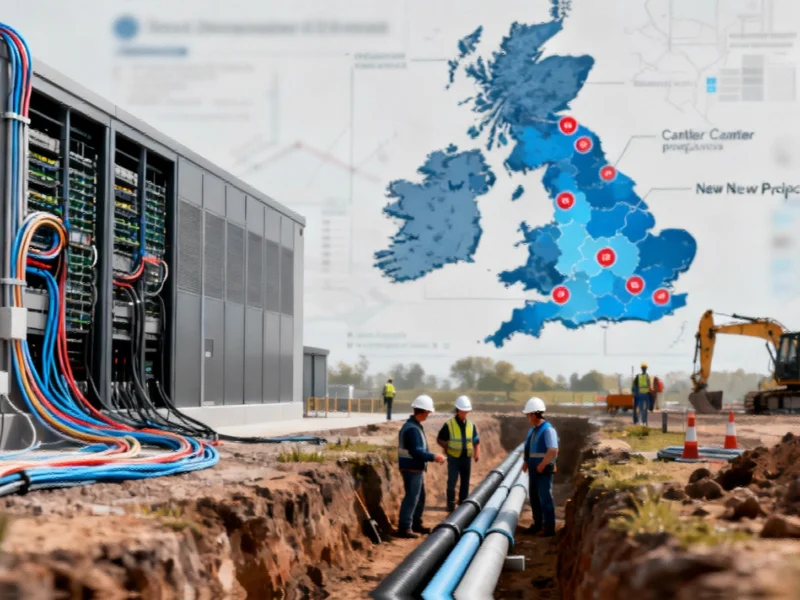A critical shortage of fiber connectivity is significantly impeding data center projects across the United Kingdom, with over 80 percent of operators reporting construction and expansion delays due to inadequate digital infrastructure. This connectivity crisis comes at a particularly challenging time as the nation races to establish itself as a global AI hub, with fiber availability emerging as the third most critical factor behind land and power in data center development decisions.
The comprehensive survey from networking specialist Neos Networks, conducted in partnership with research firm Censuswide, reveals the extensive impact of fiber shortages on UK digital infrastructure projects. The research, which gathered insights from 300 key stakeholders including data center decision-makers, enterprise IT leaders from organizations with at least 1,000 employees, and local government representatives, paints a concerning picture of infrastructure readiness.
Widespread Project Delays
The survey findings demonstrate the pervasive nature of connectivity challenges. A staggering 82 percent of UK data center operators acknowledged delaying site builds or expansion initiatives specifically due to fiber availability constraints. The problem extends beyond the data center sector, with 89 percent of local government stakeholders confirming that fiber infrastructure gaps have delayed broader infrastructure projects in their regions.
Perhaps most alarmingly, 45 percent of enterprise respondents identified fiber connectivity as the primary bottleneck restraining their AI and digital infrastructure deployments. This connectivity constraint mirrors challenges seen in other sectors, similar to how policy decisions can impact critical infrastructure development timelines across different industries.
Geographical Challenges and Infrastructure Demands
Lee Myall, CEO of Neos Networks, explained to Data Center Dynamics that the fundamental issue stems from the dependency of fiber deployment on existing duct infrastructure. “The buildout of fiber depends on duct infrastructure, which means that data center projects in areas outside of the UK’s traditional data center hotspot – Greater London – will require extensive civil engineering and planning,” Myall stated.
He elaborated on the practical challenges: “The permission can be closing roads, closing footpaths, which is not easy to do, and local landowners, and so on and so forth. So suddenly, with these new locations, the time frame for connectivity starts to become longer, and the demand on that connectivity goes up as well.”
Shifting Priorities and Regional Development
Myall noted that while connectivity traditionally ranked as the third priority for data center operators behind land acquisition and power availability, its importance has dramatically increased. “I’m not going to say a second or first, it’s still third, but the focus on it is much more intense than it was even a couple years ago,” he observed.
The UK government’s establishment of AI Growth Zones represents a strategic response to these challenges. The first zone in Culham, Oxfordshire, and the second in Blyth and Cobalt Park near Newcastle offer expedited access to power, streamlined planning processes, and various incentives. This regional development strategy reflects broader global trends where strategic infrastructure investments are reshaping economic landscapes.
Changing Geographical Preferences
The survey revealed significant shifts in data center location preferences, largely influenced by the AI Growth Zones initiative. An overwhelming 96 percent of operators confirmed that these zones have impacted their expansion and site selection decisions. A plurality of participants (28 percent) anticipate that most future UK data centers will be built in the northern regions, including Scotland and Northern England.
Despite this northern shift, Greater London maintains its appeal, with 23 percent of respondents expecting it to remain the primary location for data center development. This geographical redistribution highlights how industry evolution often requires adaptation to new operational realities across sectors.
Infrastructure Assessment and Modernization Efforts
While no survey respondents considered the UK’s fiber infrastructure completely unprepared for current demands, 41 percent judged the network infrastructure as only partially ready. This assessment underscores the urgent need for infrastructure enhancement to support the country’s digital ambitions.
Neos Networks, as a UK-based telecommunications provider operating a 34,000km fiber network with 500 exchanges, has initiated Project Reach in collaboration with network company Freshwave and railway operator Network Rail. This modernization project aims to bolster telecoms infrastructure along railway corridors, representing the type of strategic infrastructure investment that forward-thinking leaders advocate.
Broader Implications for Digital Transformation
The fiber connectivity challenge extends beyond immediate construction delays, potentially impacting the UK’s competitive position in the global AI race. As organizations increasingly rely on high-bandwidth applications and AI workloads, robust connectivity becomes not just an operational requirement but a strategic imperative. This situation parallels how technology leaders across industries are recognizing AI as a transformative force that demands adequate infrastructure support.
The current infrastructure constraints also highlight the interconnected nature of modern economic development, where digital readiness influences investment decisions across multiple sectors. Similar to how broader economic conditions can impact development timelines and investment patterns, fiber availability is emerging as a critical determinant of regional competitiveness in the digital economy.
As the UK continues its digital transformation journey, resolving the fiber infrastructure gap will require coordinated efforts between telecommunications providers, data center operators, government agencies, and local communities. The success of these collaborative initiatives will ultimately determine whether the UK can fully capitalize on its AI ambitions and maintain its position as a leading digital economy.
Based on reporting by {‘uri’: ‘datacenterdynamics.com’, ‘dataType’: ‘news’, ‘title’: ‘DCD’, ‘description’: ‘The ultimate source for data center news, analysis and opinion at https://t.co/LZ1IWZbvVu’, ‘location’: {‘type’: ‘place’, ‘geoNamesId’: ‘2643743’, ‘label’: {‘eng’: ‘London’}, ‘population’: 7556900, ‘lat’: 51.50853, ‘long’: -0.12574, ‘country’: {‘type’: ‘country’, ‘geoNamesId’: ‘2635167’, ‘label’: {‘eng’: ‘United Kingdom’}, ‘population’: 62348447, ‘lat’: 54.75844, ‘long’: -2.69531, ‘area’: 244820, ‘continent’: ‘Europe’}}, ‘locationValidated’: False, ‘ranking’: {‘importanceRank’: 344832, ‘alexaGlobalRank’: 62406, ‘alexaCountryRank’: 34716}}. This article aggregates information from publicly available sources. All trademarks and copyrights belong to their respective owners.



